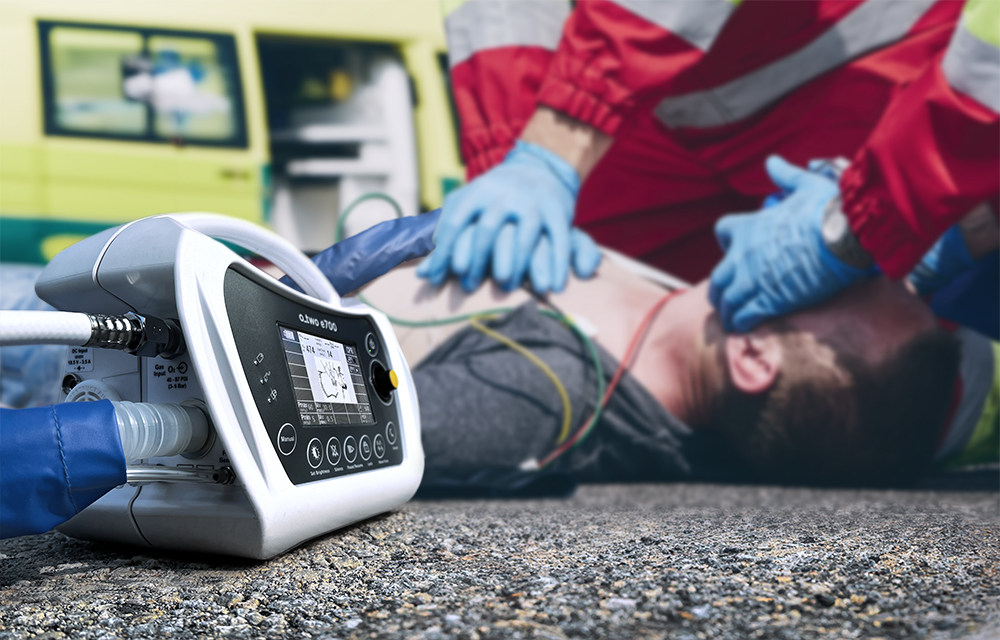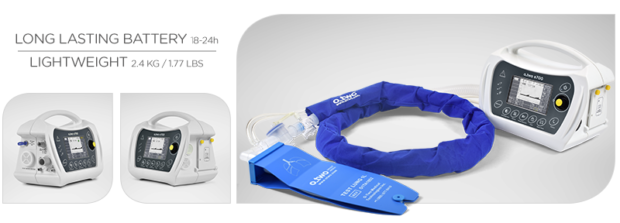Multiple Modes, Compact, Lightweight, Easy to Use.
The e700 ventilator ushers in a “new era” in controlled ventilation for resuscitation and patient transport! These electronically controlled, pneumatically powered ventilators provide a range of ventilation solutions for all types of patient requirements and all levels of pre-hospital and in-hospital healthcare professionals.

The e500 and e700 ventilators usher in a new era in controlled ventilation for resuscitation and patient transport! These electronically controlled, pneumatically powered ventilators provide a range of ventilation solutions for all types of patient requirements and all levels of pre-hospital and in-hospital healthcare professionals.

Simplicity Controllability Functionality Safety Economy

The range of ventilation solutions offered by these devices cannot be compared to any other products of their type. With an “Easily Changeable”, long-lasting (18-24h) battery pack the units are self-contained and only require attachment to a regulated oxygen supply and a transport ventilator circuit for immediate use. The easily replaceable battery can be charged while inside the ventilator or can be removed for charging and quickly
replaced by a fresh battery pack. The display lighting has both day and night modes for easy visualization of the ventilator settings in any ambient light conditions. Designed for a range of patient sizes (from large adults to infants), both models come in a very small and lightweight package.
The standardized controls on both models provide an ease-of-use concept that is second to none. There are no multiple screens to scroll through to establish patient ventilation parameters. The units have an initial, pre-set, start-up mode requiring only the selection of patient size to begin ventilation. These products are designed to speed up and simplify even the most complex ventilation setup.
e700 Ventilator Specifications
Power Source:
Compressed Oxygen, 45 to 87 PSI (3-6 Bar)
Circuit Control Source:
Electric
Ventilation modes:
A/C (VCV,PCV), SIMV w/ PSV, BiLVL w/ PSV, CPAP w/ PSV, Mask CPR and Intubated CPR
Supporting ventilation:
PSV: 0, 4-35 cmH2O (± 10% or ± 2 cmH2O)
Ventilation Rate:
5 – 60 (± 10% or ± 1BPM)
Minute Volume (L):
Calculated
Tidal Volume (ml):
50 – 2000 ± (4ml + 15%) BTPS *
Tidal Volume in CPR mode (ml):
50 – 1400 ± (4ml + 15%) BTPS *
Maximum Delivered Flow (L/min):
100 – 120
Manually Triggered Ventilation:
Yes, set flow rate or pressure will be delivered during I time then Inspiratory hold
Maximum Inspiratory hold time:
6 sec.
I:E Ratio:
1:4 – 3:1 (± 20%)
PEEP (cm H2O):
0,4-20 (± 10% or ± 2 cmH2O)
PSV:
OFF, 4 – 35 (± 10% or ± 2 cmH2O)
CPAP (cm H2O):
4-20 (± 10% or ± 2 cmH2O)
O2 (%):
60 or 100 (± 15%)
Pmax (cm H2O):
10 – 80 (± 10% or ± 2 cmH2O)
Pmin (cm H2O):
0 – 20 (± 10% or ± 2 cmH2O)
PCV (cm H2O):
4-50 (± 10% or ± 2 cmH2O)
Ti (sec.):
0.2 – 9 (± 20%)
Trigger sensitivity (L/min):
1 -15, or 2 cmH2O below baseline in CPAP mode only
Inhalation Pressure (cm H2O):
4-50 (± 10% or ± 2 cmH2O)
Pressure ventilation Termination:
20% – 80% of max. Flow
APNEA back up time (sec.):
10-60 (± 0.5s)
Battery Operating time at room temperature (hrs.):
> 18 hrs for default settings (Data obtained using fully charged new battery)
Altitude compensation:
up to 4000m (13000 feet)
Battery Hot Swap:
No
Built-in Battery charger:
Yes
AC/DC power supply:
100-240 VAC/ 19 VDC, 4.74 A
Patient circuit:
O-Two Electronic Ventilator Circuit
Mounting Bracket:
Mounting brackets for road ambulance and mobile setting
Display:
4.3″ Color TFT
Live monitoring:
Mve,Vte,Paw(AV),PAW(Peak), Rate (bpm), Battery level
Real time waveform:
Pressure or Flow
DAY/NIGHT display mode:
Yes
Parameter settings:
Control Selection Knob
Lock key function:
Yes
Pause function:
Yes
Noise level in normal use:
Less than 65 dBA
Alarms (Visual and Audible):
Gas Supply Pressure, Airway Pressure limits, Minute Volume limits, Battery status, APNEA, Breathing Circuit Integrity, Leakage and Blockage
Audible silence:
Yes, 120 second max
Dimensions (mm)
250 x 200 x 155
Weight (Kg/Lbs) with/without Battery
2.4/1.77 | 5.29/3.9
Internal Volume of the complete respiratory system (reusable and disposable):
approx. 690 ml without mask | approx. 800 ml with mask
Dead space of patient valve with elbow:
Approx. 35 ml
Compliance (disposable) hose system:
16.6 ml/kPa
Resistance of Patient Hose system (Inhalation and Exhalation):
Less than 6 cmH2O at 60 l/min & Less than 6 cmH2O at 30 l/min
Environment condition
Ventilator:
Operating Continuous – 18oC to +40oC, Rh: 15% to 95% | OperatingTransient** – 20oC to +50oC, Rh: 15% to 95% | Storage – 40oC to +60oC, Rh: 15% to 95%
Battery Pack:
Charge: 0oC to +40oC | Discharge | – 20oC to +60oC | Storage: – 20oC to +35oC, low humidity and no corrosive gas atmosphere.
Patient Circuit:
Operating: – – 18oC to +50oC, Rh: 15% to 95% | Storage: – – 20oC to +60oC, Rh: 15% to 95%
* BTPS: Volume measurements corrected to Body temperature 37oC and Barometric pressure 101.3Kpa under saturated conditions (100% Humidity). Note: Measurement uncertainty: 5% for volume parameters and 6% for pressure parameters.
This product has a two year warranty against manufacturers defects.
Device class per MDD:
II b
Classification Per Iec60601-1 IEC60601-1 |
Protection against electric shock: Class II, Type BF |
Protection against water: IP X4
01EVE700
e700 – Electronic Automatic Transport Ventilator c/w Disposable Patient Circuit, Resuscitation Mask, 6 Foot Supply Hose with 9/16” DISS Fittings, Calibrated Test Lung and Power Supply (Specify Country of Use)
Each
Accessories
01CV8030-CS
O-Two Medical Single-Use Electronic Transport Ventilator 6 Foot Circuit with Protective Sleeve. For e500 and e700
Case/10
01CV7035
O-Two Medical “e” Series Ventilator “Smart Mount” Multi-configuration Mounting Bracket (Ambulance Cot, Hospital Stretcher, Bed, Roll Stand)
Each
01CV8040-CS
O-Two Medical “e” Series Ventilator Replacement Intake Filter/Cover
Case/10
01TA1852
O-Two Medical “e” Series Ventilator Replacement 1 Litre Test Lung with Compliance Restrictor
Each
01FV4303-DISS
O-Two 6 Foot (1.85 Meter) O2 Supply Hose with 9/16 DISS Nut and 9/16” DISS Nut Ventilator Connection
Each
01CV9100
O-Two Medical “e” Series Replacement Lithium Ion Replacement Battery
Each
01CV0106
Power supply cord for eSeries power supply (US/CA)
Each
01CV0102-EU
Power supply cord for eSeries power supply (European)
Each
01TA7650
Leak test kit for e-vents
Each
02FM4999-CS
O-Two universal mask
Case/12
02FM5207-CS
O-Two Disposable Cuffed Child/Small Adult #3 Mask with Hook Ring
Case/12
02FM5000-CS
O-Two Disposable Cuffed Adult #4 Mask with Hook Ring
Case/12
02FM5001-CS
O-Two Disposable Cuffed Large Adult #5 Mask with Hook Ring
Case/12
e700 Ventilator Odering Information
ACCESSORIES
Altomatic Ventilation
Immediate Care
Demand Valve & Resuscitation Kits
Pressure Regulators & O2 Administrators
- Pressure Regulators
- Multi Patient Unit
- Statvac II
- Oxygen Flow Controller
- Finger Tip Pulse Oxymeter


